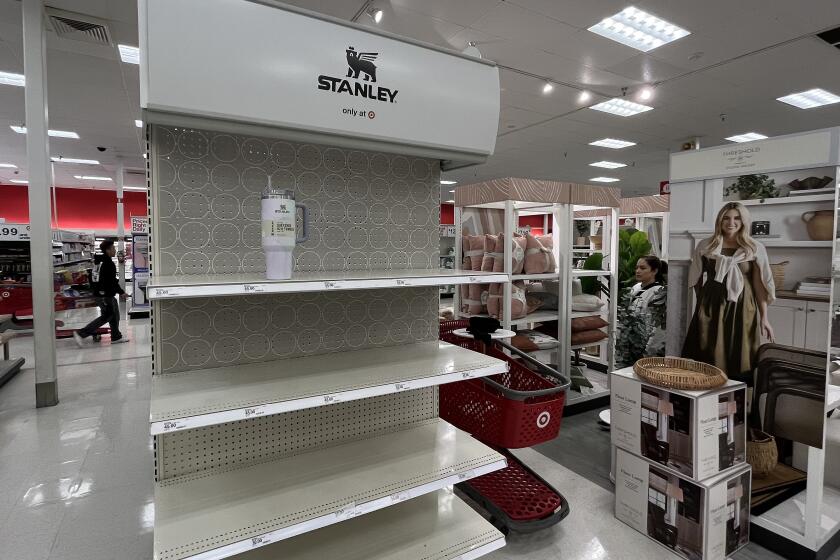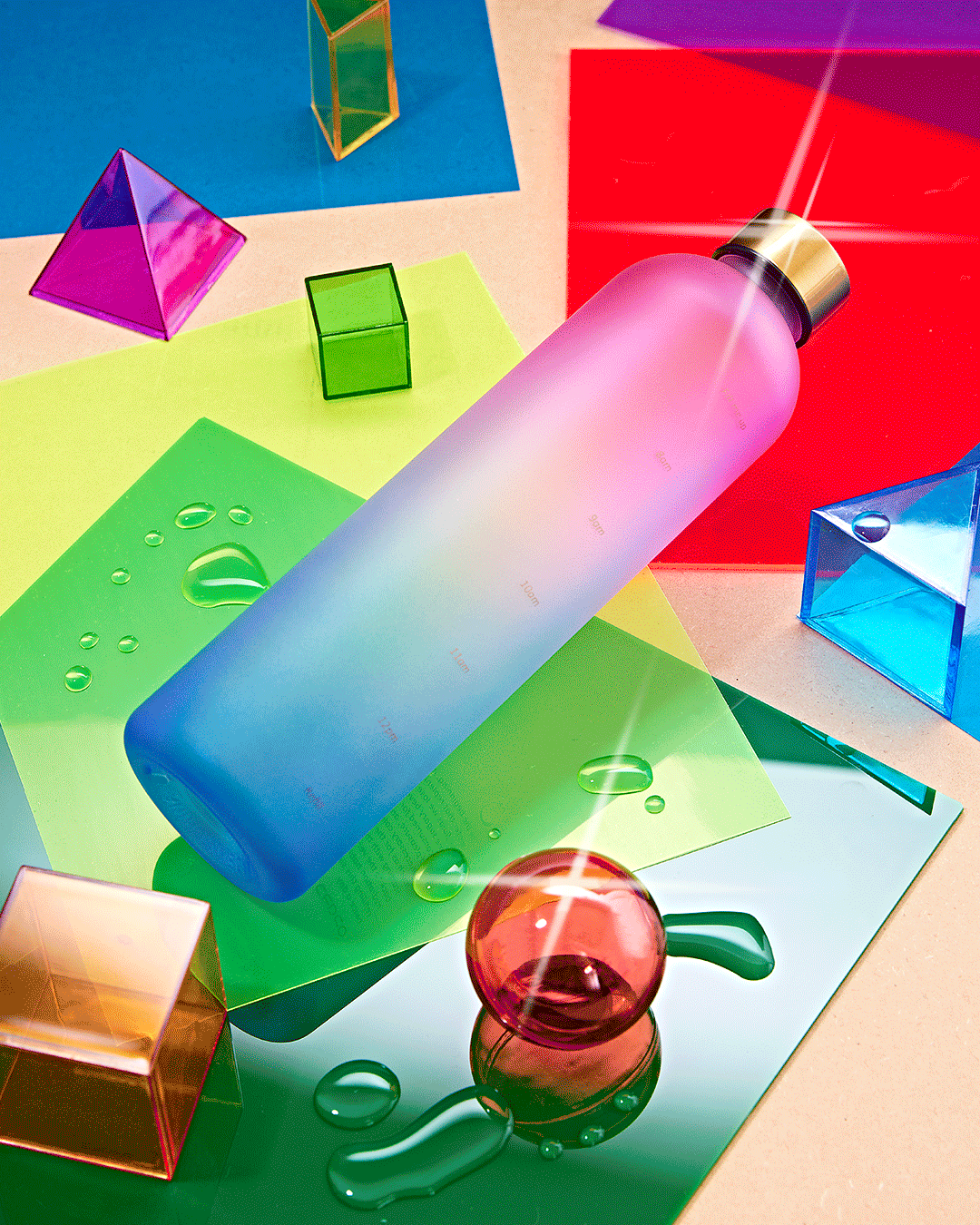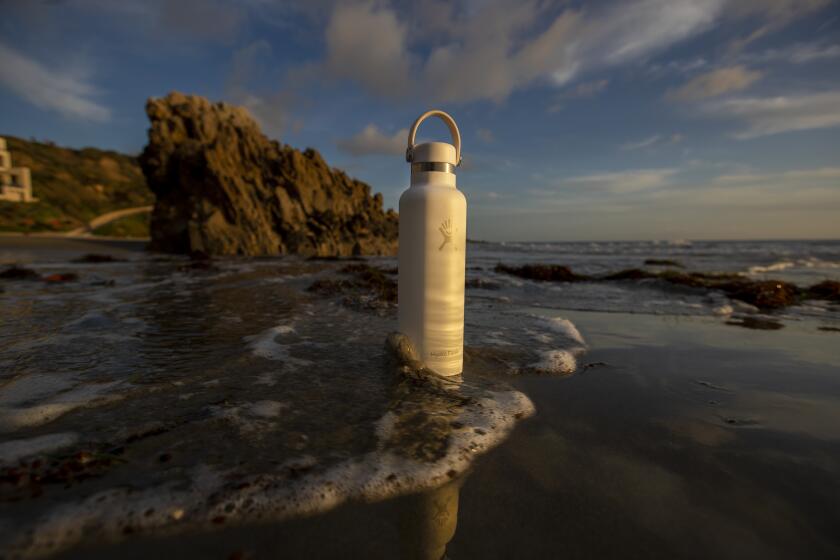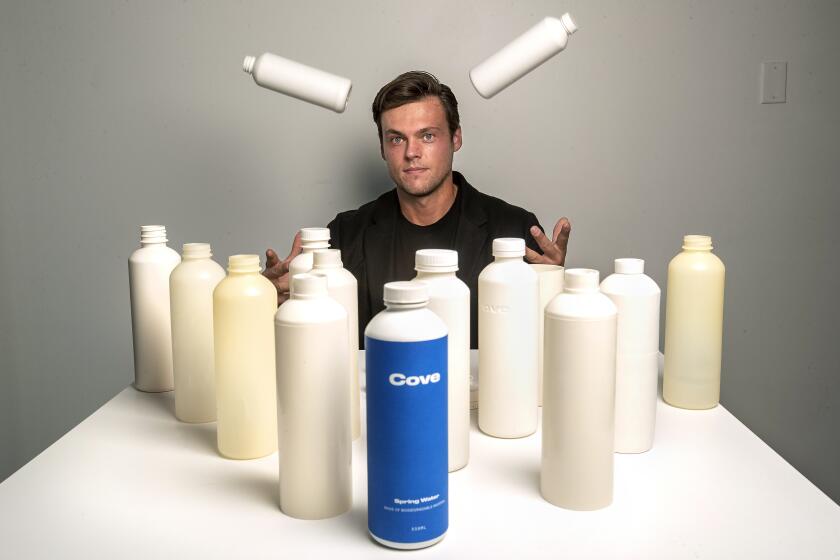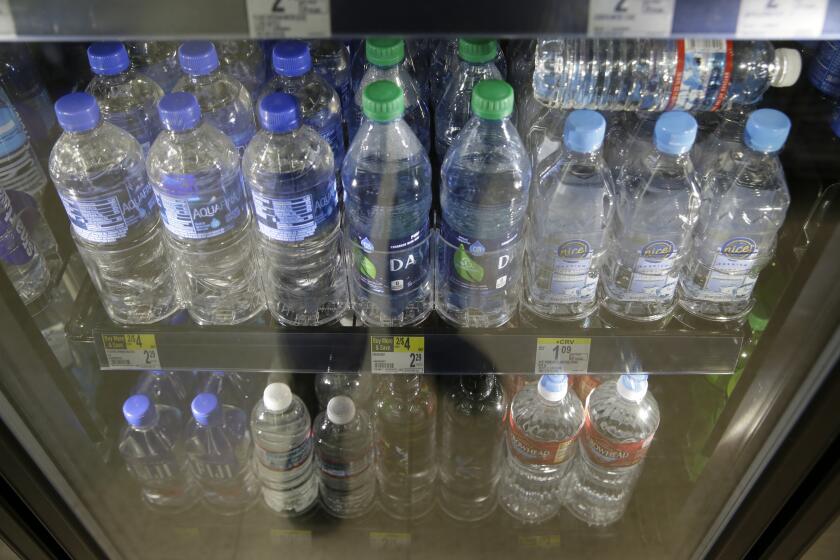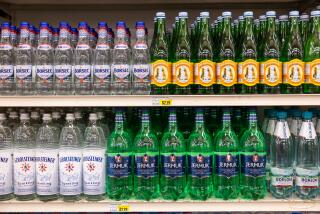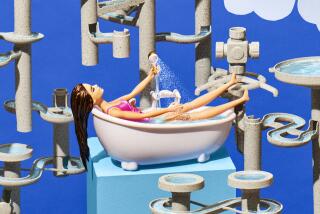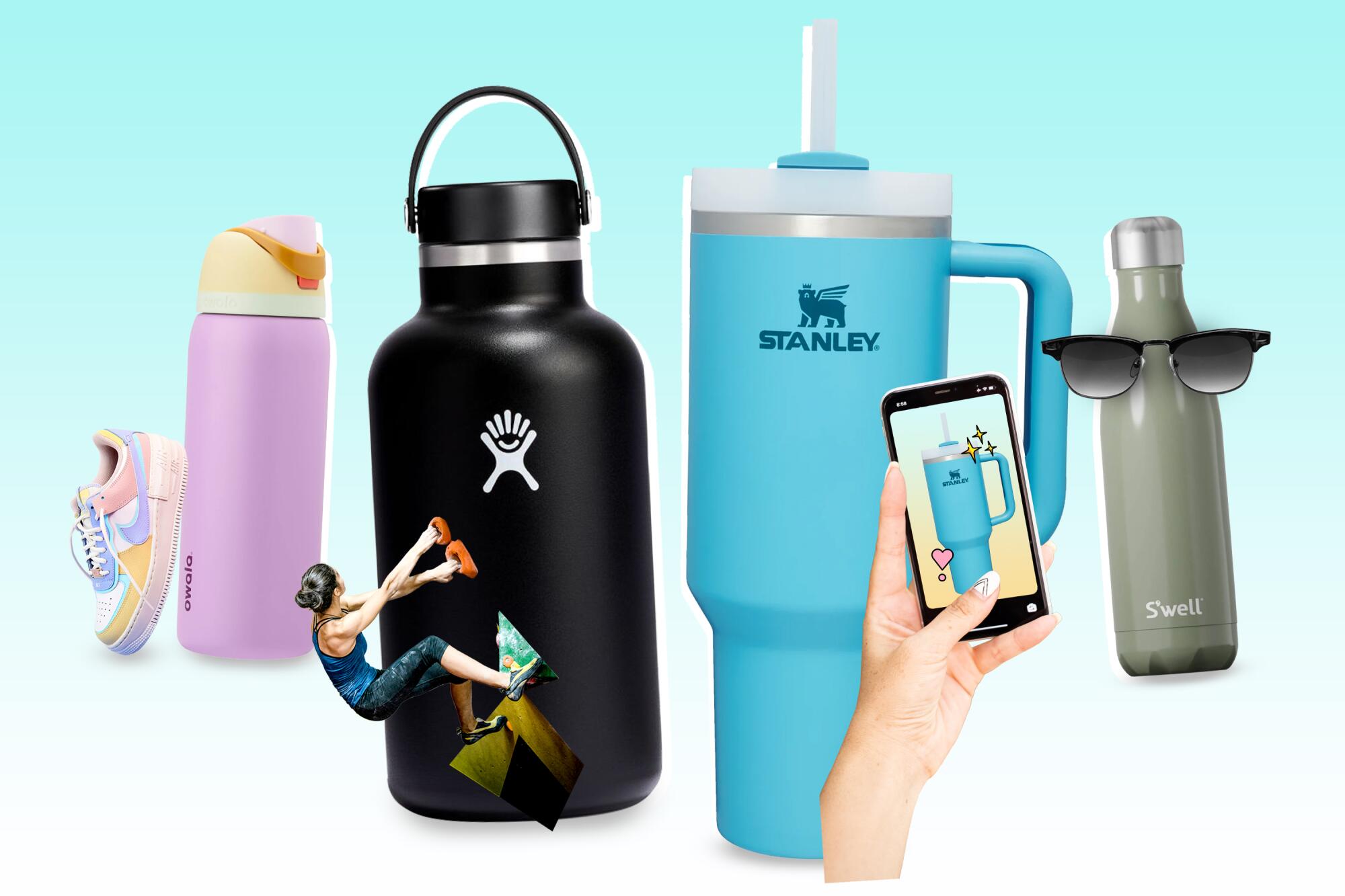
- Share via
If you’ve spent any amount of time on TikTok or talking to your 12-year-old niece, you’ve probably heard of the Stanley cup by now.
The 40 oz. insulated tumbler with a handle has led to long lines, fights and a crazy resale market.
We’re only 11 days into the new year, and already some marketers have gone so far as to proclaim 2024 the “Year of the Water Bottle.” Hydration vessels, they say, may be this year’s “most covetable, most fashionable accessory.”
But the Stanley cup is just the latest in a long line of water bottle trends, aided by social media virality and declared cool by the arbitrators of the internet — teenage girls. Before Stanley, it was Hydro Flask, and before that, S’well. Owala took off on social media last year as well.
Collectors and sellers attribute the craze to the limited availability and collaborations with sellers like Starbucks, as well as to viral TikTok videos.
At the ripe old age of 24, I’ve remained faithful to my plastic Nalgene bottle, a brand that has seen its own surges in popularity, for more than five years. It’s covered in stickers from my college days and practically indestructible, perfect for my outdoor climbing trips and propensity for dropping things. I prefer to drink my water at room temperature rather than ice cold — controversial, I know — and I don’t want to lug around anything heavy. I’m an unabashed Nalgene person, and I won’t be replacing it anytime soon.
Given the fierce devotion with which some fans wield their Stanleys, I wanted to know if water bottles really have become the latest extensions of our identities. So I spent a day traversing the city to see what Angelenos have to say. Here are my entirely unscientific findings.
Stanley: The trendsetter

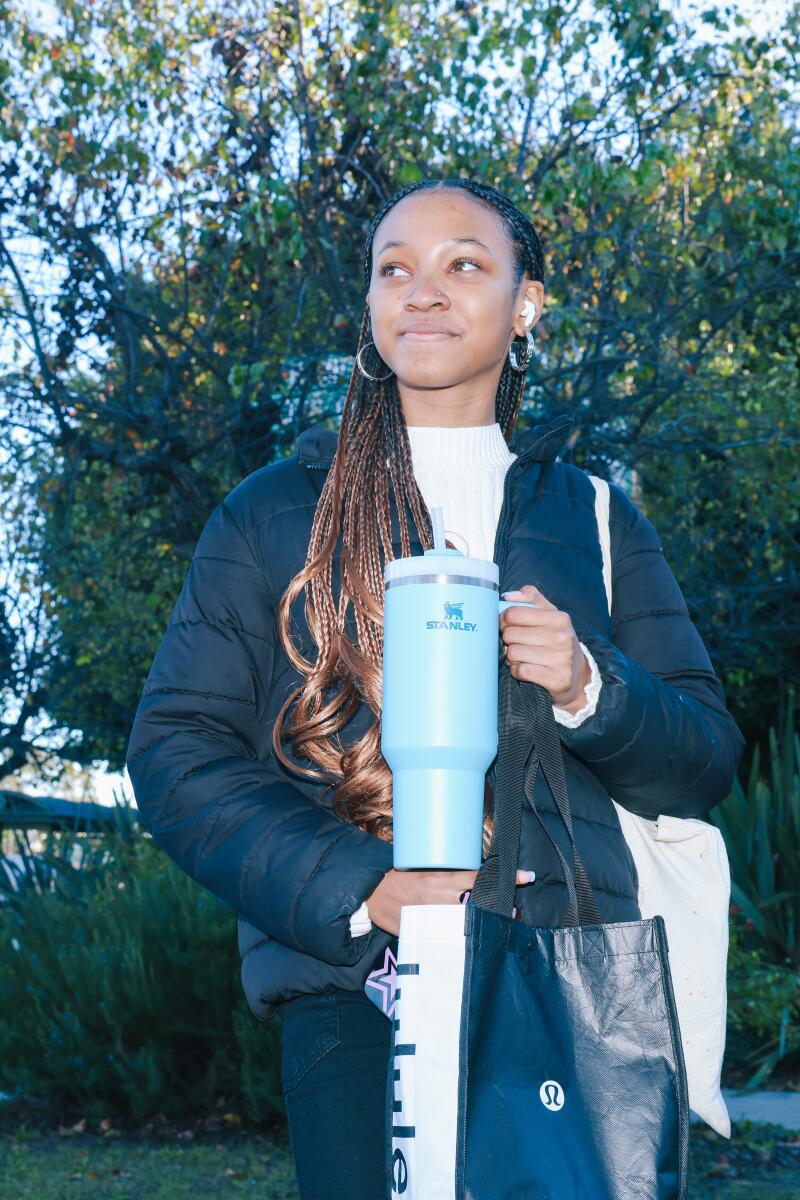
Kimora Johnson poses for a portrait with a Stanley Cup branded water bottle outside her high school in Culver City. She recently purchased the cup, which has been selling out at retailers, from Urban Outfitters. (Dania Maxwell/Los Angeles Times)
One of the most coveted items currently by tweens across America, it seems, is the Stanley Quencher tumbler. Target shelves were devoid of them when I checked, but 15-year-old Kimora Johnson knew where to find one — Urban Outfitters.
Johnson proudly toted her light teal blue Stanley as she walked out of school in Culver City on Monday. It matched her nails.
“I just like the color and it keeps my water cold. It’s really nice,” she said. She was quite pleased to have snagged one over winter break after seeing it all over TikTok, Instagram and the news.
The cup’s popularity was likely initially sparked by a woman’s viral TikTok video in November of a Stanley cup that survived a car fire. In response, the Stanley company offered to replace her cup — and her car. Since then, influencers and popular collaborations have propelled the Stanley cup to new heights. (Stanley couldn’t be reached for comment on the trend.)
L.A. fashion trend analysis: designer water bottles
USC master’s student Hannah Gomez, on the other hand, initially thought people were talking about the National Hockey League’s Stanley Cup. She received the popular Stanley tumbler as a gift from her younger sister and did not realize the cachet it would have.
“I’ve gotten like five comments on it today,” the 26-year-old said after I accosted her on her way to grab dinner. “People don’t usually stop you for your water bottle.”
She likes the handle design and straw, which she said makes her drink more water throughout the day. Plus, it kept her water ice cold from 8 a.m. to 5 p.m.
Runyon Canyon hikers Priscilla Ramirez and Diana Gonzalez said they bought one for its ability to keep water cold — a must at Gonzalez’s warehouse job in the summer. — but they also were intrigued after hearing it could float in a pool. They confirmed that it does, indeed, float in a pool.
Gonzalez considered buying a red Stanley featured in Target’s Valentine’s Day collection but quickly changed her mind after seeing the hubbub around them.
“I wanted it, but I will not go and fight for one,” said Gonzalez, 33. For hiking purposes, they opted to buy something cheaper at Marshalls.
Hydro Flask: The populist
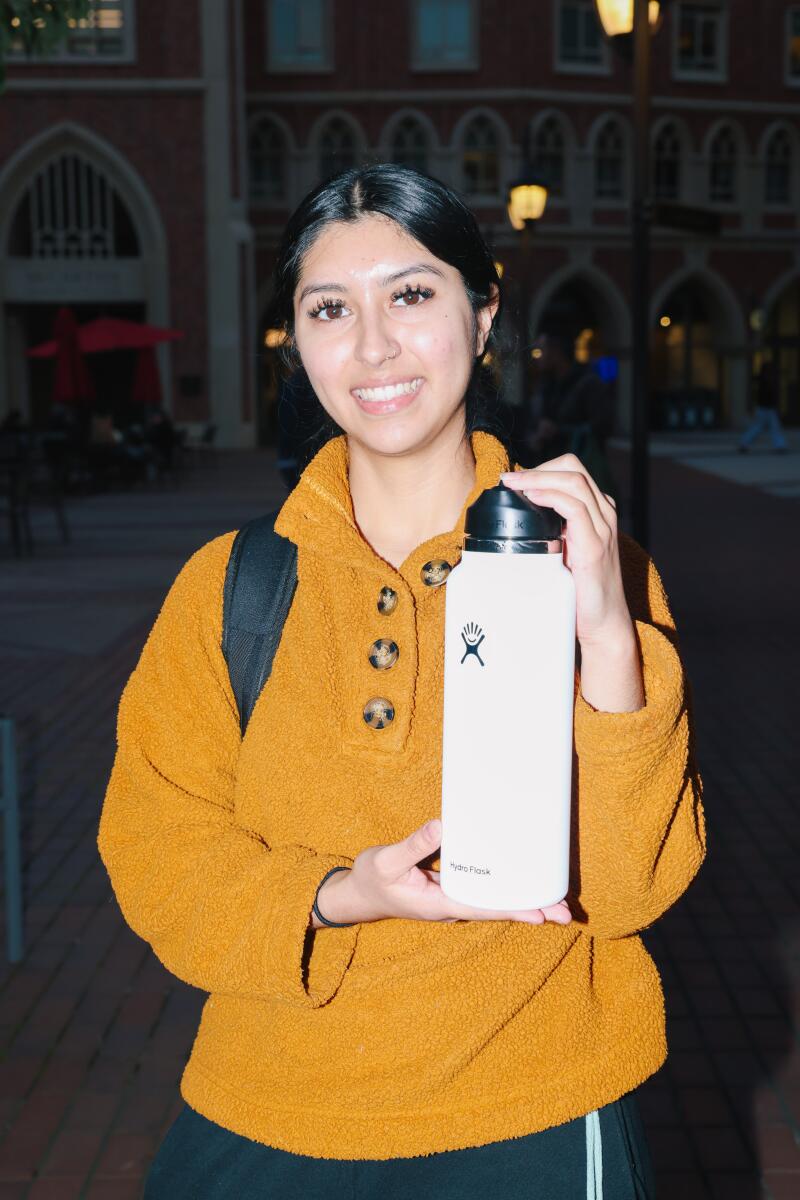
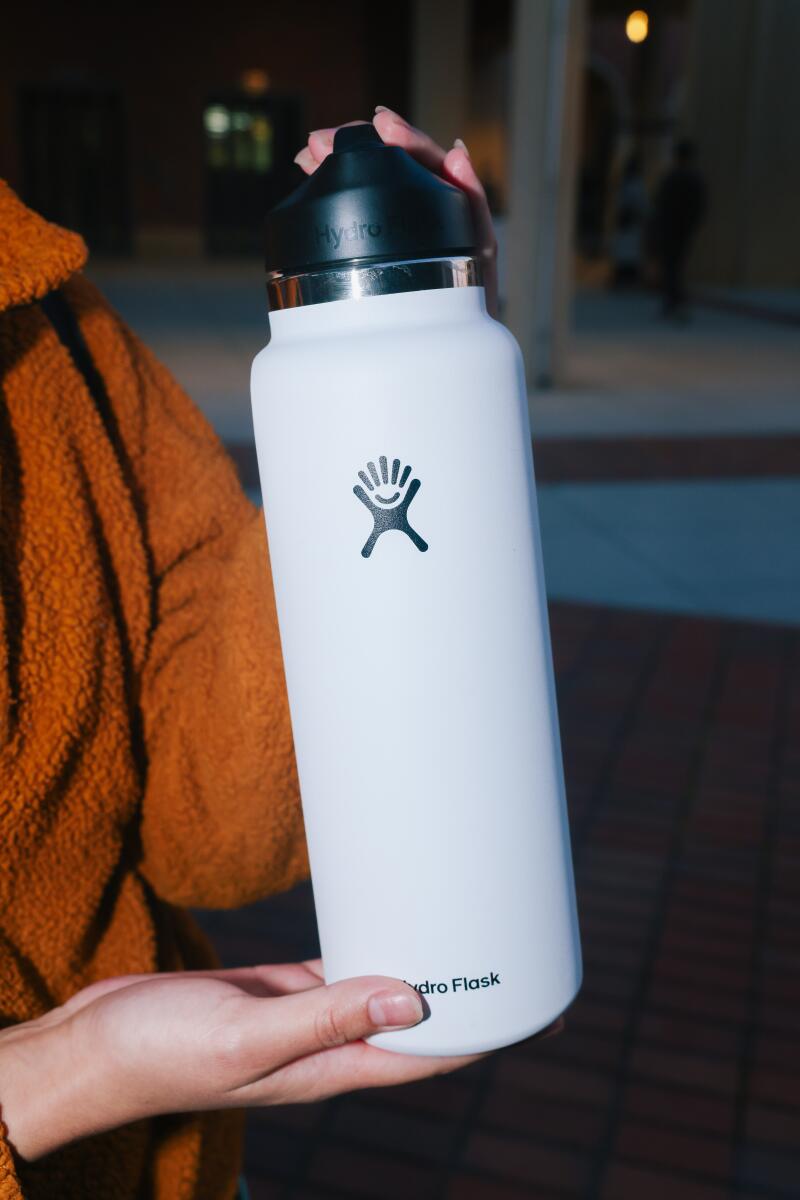
Leslie Compean shows off her Hydro Flask water bottle at the USC University Village. The bottle was a gift from her sister for the holidays. (Dania Maxwell/Los Angeles Times)
In 2020, the Hydro Flask was the “it” water bottle, the kind that middle schoolers put at the top of their Christmas lists just like the Stanley cup of today. Teens carried them separately rather than in their backpacks, covering them with stickers and artwork. They were a statement that you were cool and eco-conscious.
According to the company, the average Hydro Flask purchaser ranges from teens to mid-30s and “live full and active lives.” Of all the reusable water bottles I could identify in public, I saw the most Hydro Flasks.
On a Monday afternoon at USC, students lugged their Hydro Flasks across campus in backpacks and on skateboards in all different colors.
Leslie Compean, 22, carried a white Hydro Flask she received from her sister for Christmas. She already owned a gray bottle from the same brand but wanted a larger one.
“I feel like I’m a simple person,” Compean said. Even if unintentional, it seemed to match her white shoes, paired with black pants and a mustard yellow sweater.
How Hydro Flask water bottles became a hot fashion accessory is a story mixing environmentalism, self-care and the simple desire to keep drinks cold.
She doesn’t care about trends, she said, but this bottle “does the job.”
Over at Santa Monica’s Third Street Promenade, Alfredo Torales, 39, sat outside during his lunch break with a black Hydro Flask. It came from the ever-growing lost-and-found pile at the high school his wife works at.
“These boys always leave Hydro Flasks behind as if they’re worth nothing,” Torales said. “If no one scoops it up after a few weeks, she brings them home.”
He doesn’t particularly care about what kind of water bottle he has, but he’s a Bruin, so that means “no SC colors ever.”
Owala: The color-forward accessory
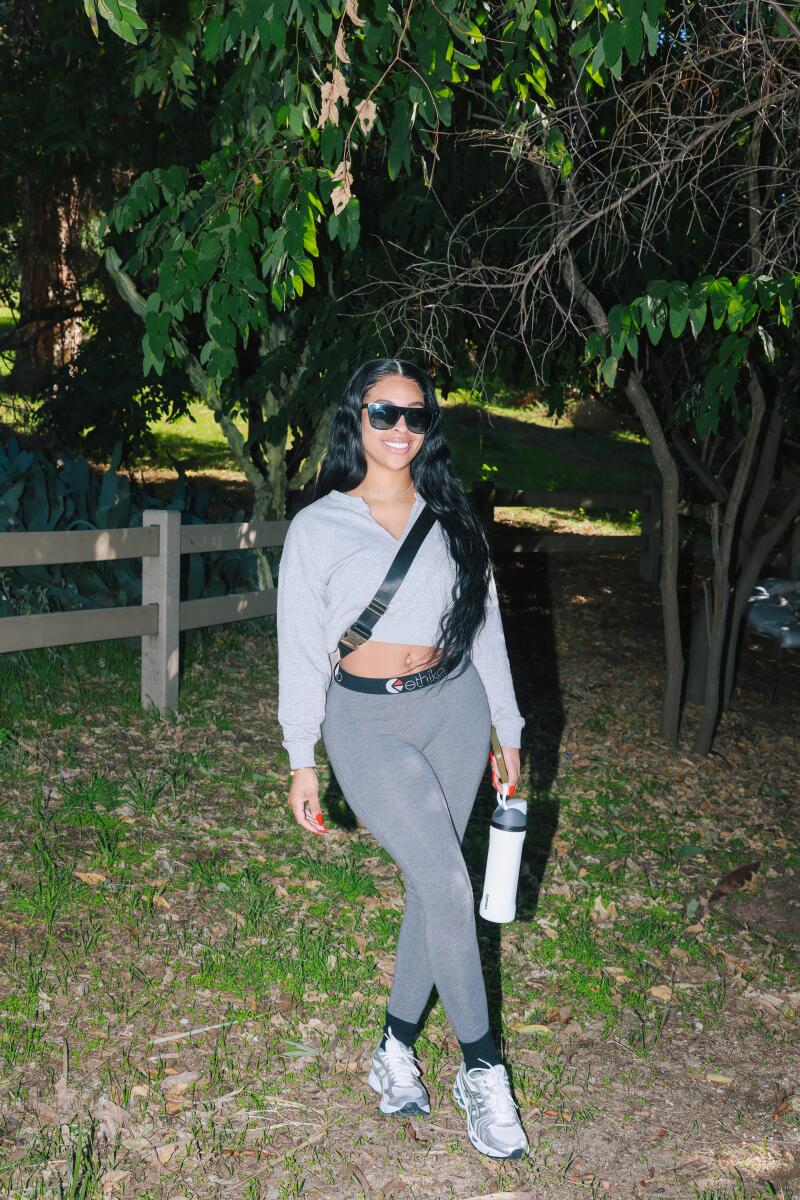
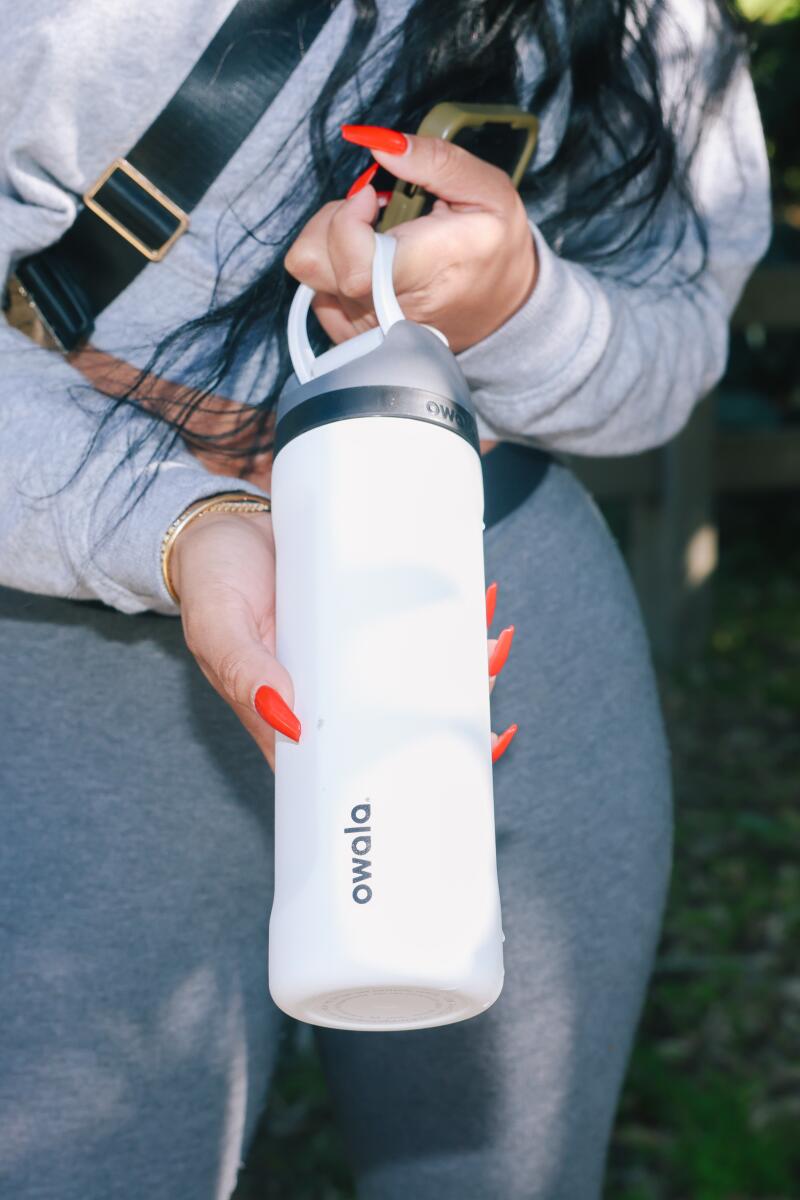
Denai Blackshire sported an Owala water bottle that matched her outfit while hiking recently at Runyon Canyon. (Dania Maxwell/Los Angeles Times)
Unlike other reusable water bottles, Owala screams color.
Each iteration of its flagship FreeSip bottle has at least three different colors for the body, rim and spout. Online, they have names like “Can You See Me?” with bright pinks and reds, and “Gemstone Chic,” with rich jewel tones.
“Water bottles are a cool tool for self-expression,” said Chad Sorensen, senior brand manager for Owala. “We give you an outlet, a vehicle to do that.”
Sorensen said the brand has picked up older Gen Z and millennial women in particular as fans. As the water bottle space has become more and more about fashion, the company aims to market its products accordingly.
Denai Blackshire, 32, carried a white, black and gray Owala while hiking at Runyon Canyon that matched her gray sweats.
“When you go hiking, you still want to look aesthetically put together,” Blackshire said. An ex-partner bought her the water bottle after she said she wanted to hike more. Her main requirement: It had to be cute.
Culver City-based Cove aims for a December pilot launch of what it calls the first water bottle made entirely from biodegradable materials.
She also thought the design was clever — a straw for sipping and a larger spout for guzzling. It was named one of Time’s Best Inventions of 2023.
Owala has seen particular success with nurses, Sorensen said, who are stuck wearing the same thing every day but can use a colorful water bottle to “mix it up.”
Sorensen likens the water bottles to sneakers — you technically need only one, but you have multiple to match different wardrobes. Owala drops a limited-edition color every other Tuesday, like sneaker drops, and once they’re gone, they’re gone.
S’well: The stylish classic
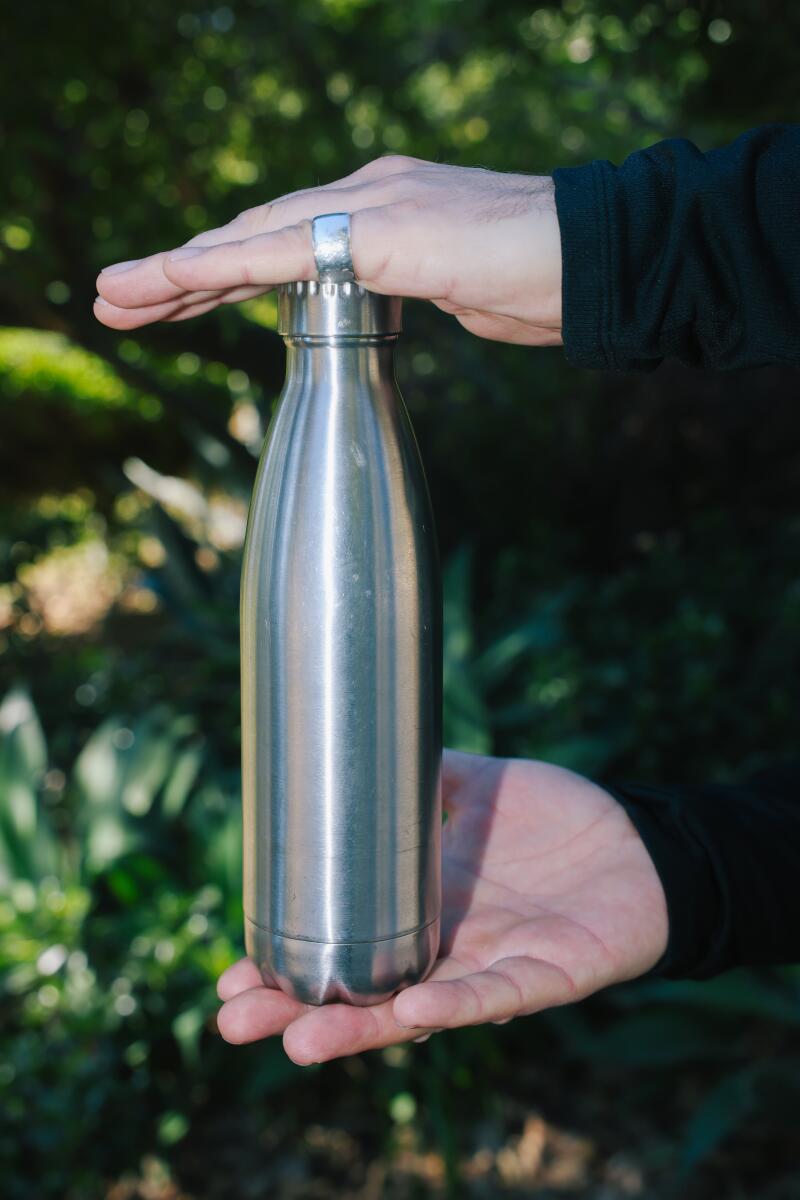
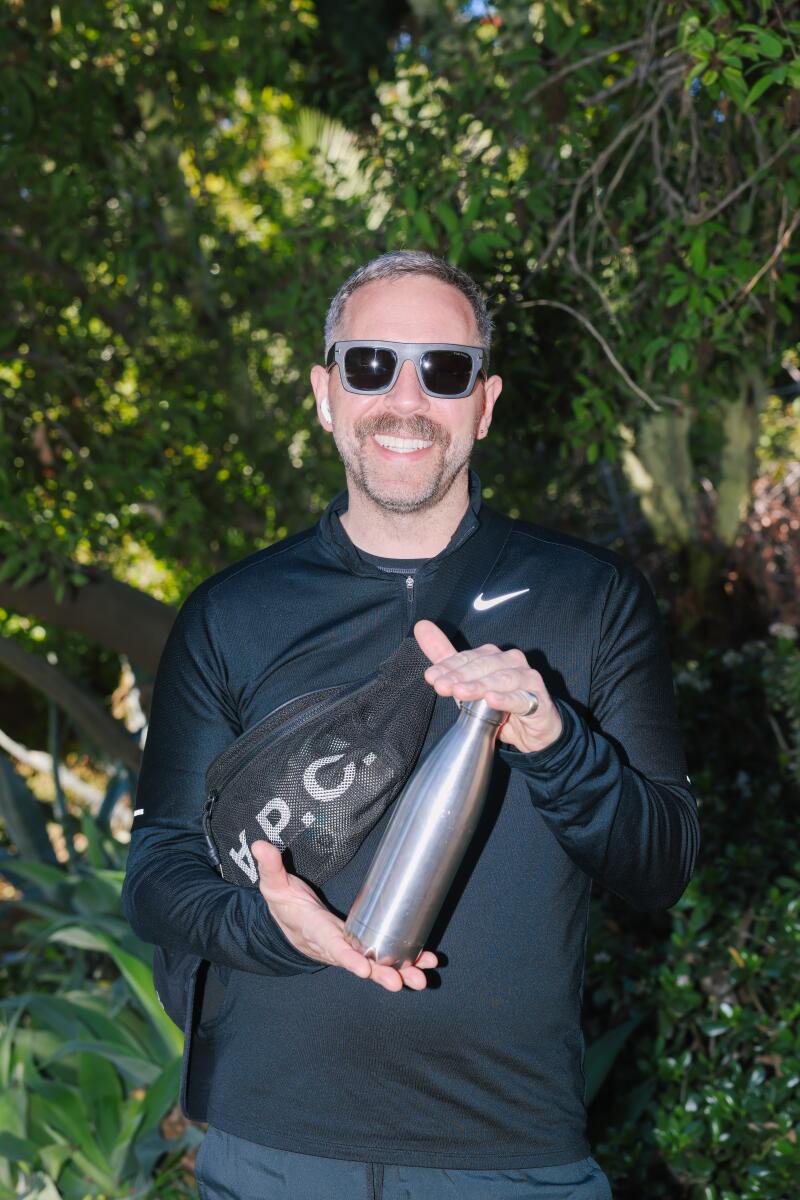
Alex Holt said he chose his particular S’well water bottle, which he toted along for a hike at Runyon Canyon, because it matches his lunchbox. The stainless steel finish fits his personal brand, his friends told him. (Dania Maxwell/Los Angeles Times)
When I was in high school, everyone had a S’well bottle. I would call it the first “fashionable” water bottle, with an array of artsy finishes, including rose gold metallic, glossy faux marble and a smooth, understated wooden print.
It has a distinctive slim neck design and is small enough to fit in the side pocket of most backpacks. The downsides: It’s hard to fit ice cubes in the opening, and the svelte bottles are less visible carried inside a backpack.
Alex Holt, 44, carried one with a stainless steel finish during a morning hike at Runyon Canyon. He chose that one because it matches his lunchbox.
“It’s like your branding,” his co-workers told him. He said it’s also sturdy and keeps his water cold, sparkling or still.
“The idea is that we have them for a really long time,” Holt said, rather than changing them with trends. S’well declined to comment.
Nalgene: The sturdy workhorse
Carrying a backpack and rollerblades, Goksu Okar wandered around the Santa Monica REI’s water bottle section, carefully examining the plethora of brands that were available — Yeti, Nalgene, Stanley, Hydro Flask, Camelbak and more.
After a few minutes, she settled on a plastic Nalgene bottle. (I silently cheered from the sidelines.)
Okar, 32, said she already had a “really big” water bottle that she drinks from all day and wanted a smaller, more portable one. If she wanted to spend more, she would’ve bought a Yeti ($28 for a similar style). But the Nalgene is cheap and seemed sturdy — what more could she ask for? Before we could get into more specifics, she ran off to catch the bus.
While Nalgene bottles can’t keep your water cold, they’re relatively inexpensive. The standard 32-ounce wide-mouth bottle is only $16.99, while the other brands in this roundup cost $30 or more. And if you break it, the company will replace it.
Eric Hansen, Nalgene’s marketing director, described the average customer as: “18-45, professional, active, engaged and passionate.” But above all, they’re loyal. The company has received stories and photos of customers with tattoos of the Nalgene bottle silhouette. The brand has even received invitations to weddings and graduations.
“If that’s not engagement and passion, I don’t know what is,” said Hansen, who refers to Nalgene as the “OG” water bottle. At 75 years old, Nalgene doesn’t have to chase trends or consumers, he added.
The best water bottle? Anything reusable
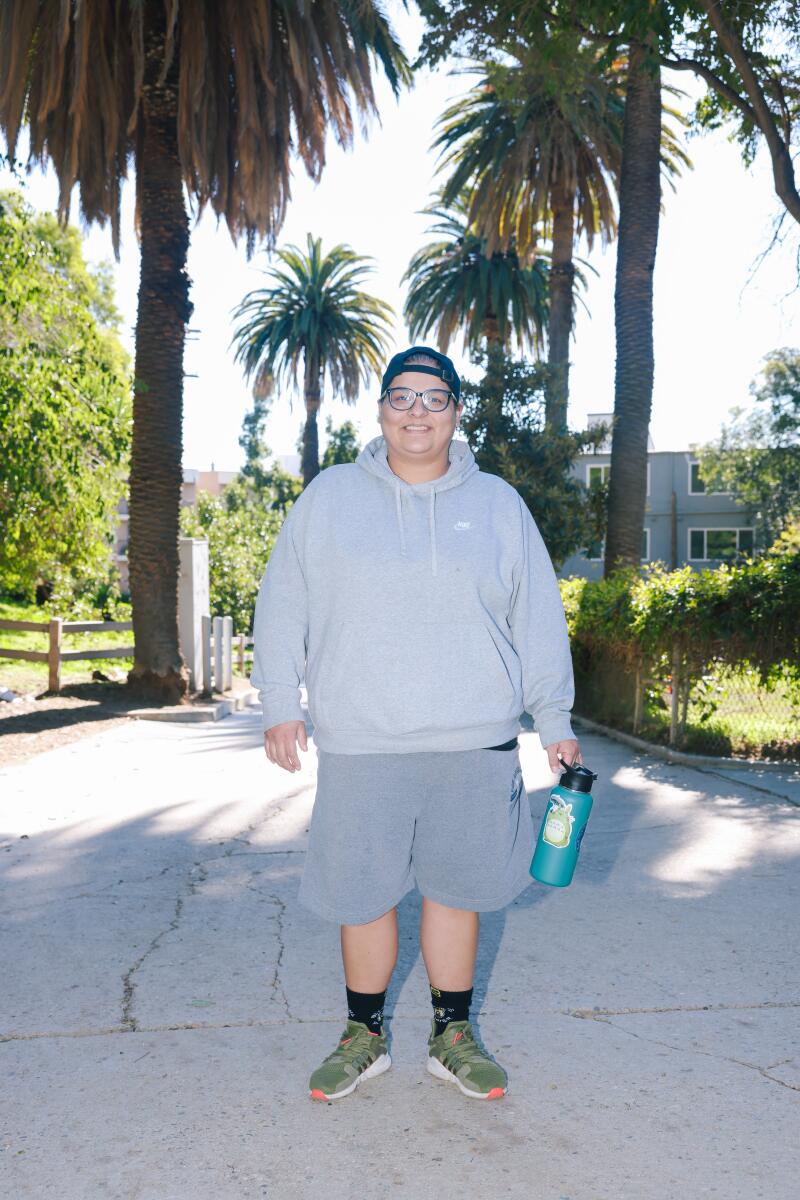
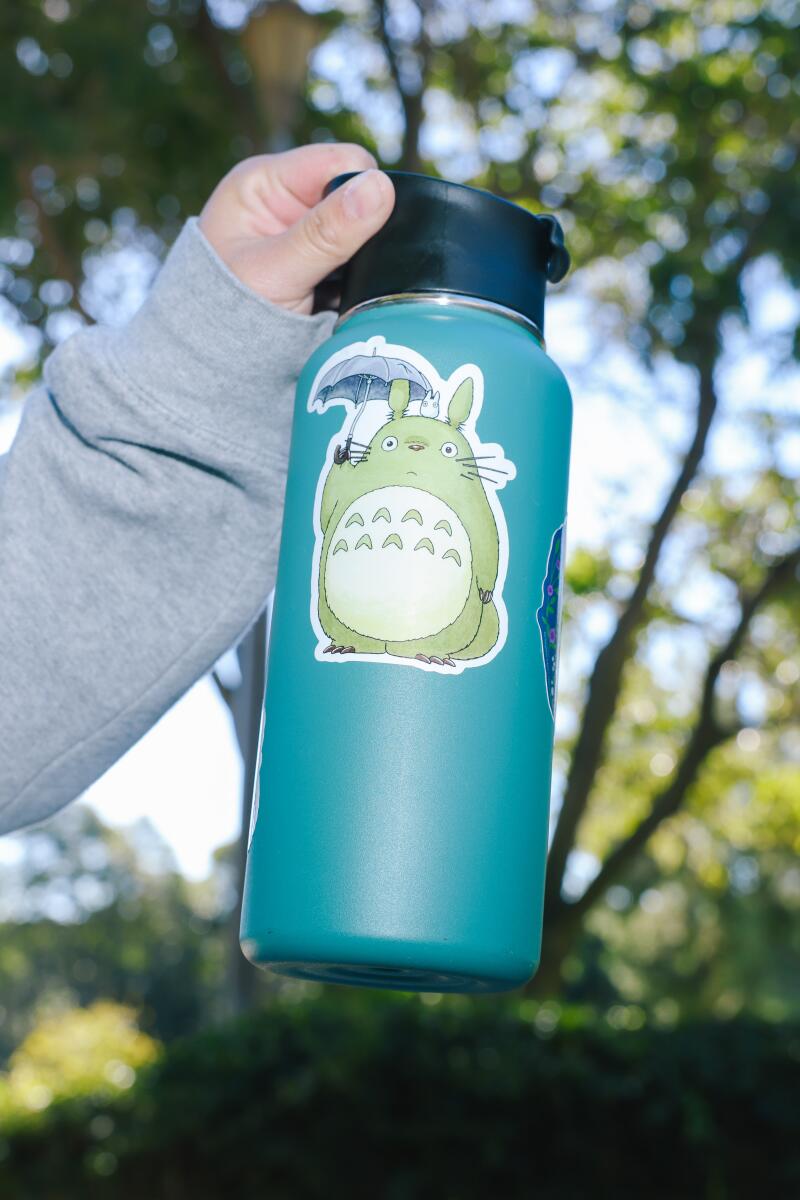
Priscilla Ramirez, photographed at Runyon Canyon, packs a Hydrapeak water bottle she purchased from Marshalls because she said it keeps her water cold. (Dania Maxwell/Los Angeles Times)
“My rule of thumb is, don’t spend more than $20 on a water bottle,” said 18-year-old Sofie Fisher. “Maybe $25.”
Fisher had some thoughts about water bottle trends Monday afternoon after school in Culver City as she waited for her ride.
“Fads have been like a thing forever,” she said. It’s more important to “try to reuse what you have and not consume more.”
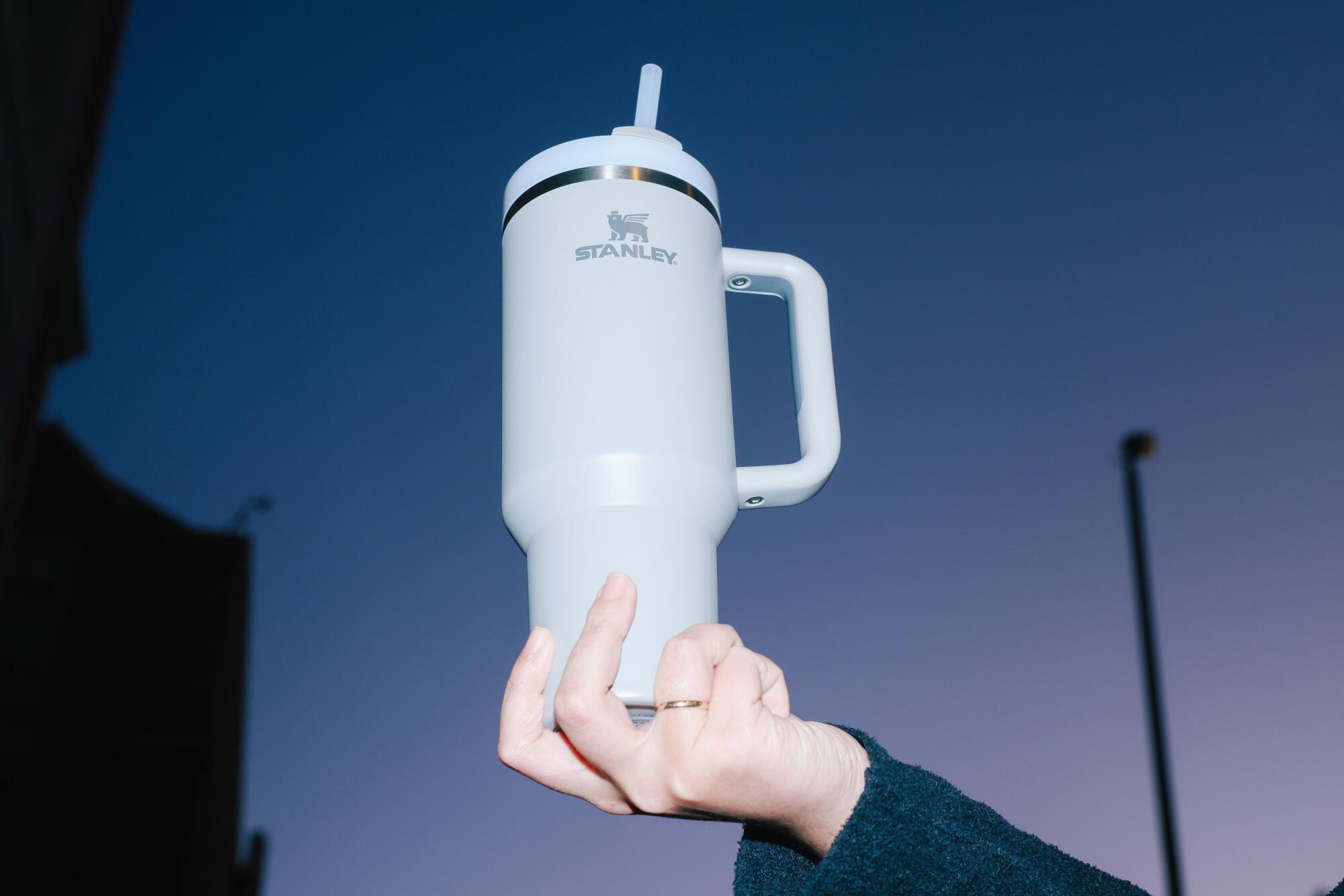
Fisher uses a Tripalink-branded water bottle she thinks her mom bought on Facebook Marketplace (Tripalink is a property management startup). She doesn’t care for Stanley or any other trendy bottle.
“It’s forced consumerism,” she said.
But if you’re still using single-use plastic bottles?
It’s 2024. Not a great look.
Nanoplastics are microscopic flecks so small that they can be absorbed into human cells and tissue, as well as cross the blood-brain barrier.
More to Read
Inside the business of entertainment
The Wide Shot brings you news, analysis and insights on everything from streaming wars to production — and what it all means for the future.
You may occasionally receive promotional content from the Los Angeles Times.
